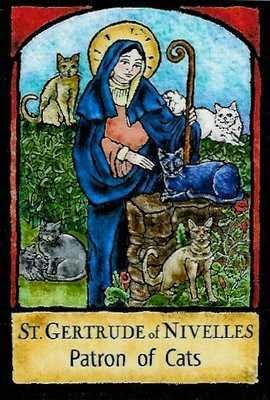Some of the more enduring stories about old New Orleans center around that voodoo practitioner, Marie Laveau. What is fact and what is an entertaining story is hard to separate at times.
First of all, there was two Marie Laveaus; both with reputations for practicing voodoo.
The first Marie Laveau (1801-1881, probably) was a free woman of color* who sold liquor and acted as a hairdresser. She married Jacques Paris; but he died in 1820. She took a lover and is said to have had 15 children, including the second Marie Laveau. She was the first Voodoo celebrity or superstar. And, as such, she is often represented as a sinister figure.
However, in reading into her life a bit further, it seems that this good woman had a depth of character that was not mentioned in the alarmist stories about how she possibly practiced voodoo. In fact, practically all voodoo was performed for beneficial intent: to get money, for romance, to sell a house, to keep a husband or boyfriend faithful, and so on. Her reputation and that of other voodoo practitioners needs rehabilitation, and soon!
Here's an obituary from the Daily Picyaune marking her passing that may have been a better fit to her actual character than the character assassination that was to come from ignorant and sensationalistic writers since it came from her time frame and not later when the weird stuff got added on:
DEATH OF MARIE LAVEAU
A WOMAN WITH A WONDERFUL HISTORY ALMOST A CENTURY OLD,
CARRIED TO THE TOMB YESTERDAY EVENING.
Those who have passed by the quaint old house on St. Ann, between Rampart and Burgundy streets with the high frail looking fence in front over which a tree or two is visible, have been within the last few years, noticed through the open gateway a decrepid old lady with snow white hair, and a smile of peace and contentment lighting up her golden features. For a few years past she has been missed from her accustomed place. The feeble old lady lay upon her bed with her daughter and grand children around her ministering to her wants.
On Wednesday the invalid sank into the sleep, which knows no waking. Those whom she had befriended crowded into the little room where she was exposed, in order to obtain a last look at the features, smiling even in death, of her who had been so kind to them.
At 5 o'clock yesterday evening Marie Laveau was buried in her family tomb in St. Louis Cemetery No. 1. Her remains were followed to the grave by a large concourse of people, the most prominent and the most humble joining in paying their last respects to the dead. Father Mignot conducted the funeral services.
Marie Laveau was born ninety-eight years ago. Her father was a rich planter, who was prominent in all public affairs, and served in the Legislature of this State. Her mother was Marguerite Henry, and her grandmother was Marguerite Semard. All were beautiful women of color. The gift of beauty was hereditary in the family, and Marie inherited it in the fullest degree. When she was twenty-five years old she was led to the altar by Jacques Paris, a carpenter. This marriage took place at the St. Louis Cathedral. Pere Antoine, of beloved memory, conducting the service, and Mr. Mazureau the famous lawyer, acting as witness. A year afterwards Mr. Paris disappeared, and no one knows to this day what became of him. After waiting a year for his return she married Capt. Christophe Glapion. The latter was also very prominent here, and served with distinction in the battalion of men of San Domingo, under D'Aquin, with Jackson in the war of 1815.
Fifteen children were the result of their marriage. Only one of these is now alive. Capt. Glapion died greatly registered, on the 26th of June, 1855. Five years afterwards Marie Laveau, became ill, and has been sick ever since, her indisposition
becoming more pronounced and painful within the last ten years.
Besides being very beautiful Marie also was very wise. She was skillful in the practice of medicine and was acquainted with the valuable healing qualities of indigenous herbs.
She was very successful as a nurse, wonderful stories being told of her exploits at the sick bed. In yellow fever and cholera epidemics she was always called upon to nurse the sick, and always responded promptly. Her skill and knowledge earned her the friendship and approbation, of those sufficiently cultivated, but the ignorant attributed her success to unnatural means and held her in constant dread.
Notably in 1853 a committee of gentlemen, appointed at a mass meeting held at Globe Hall, waited on Marie and requested her on behalf of the people to minister to the fever stricken. She went out and fought the pestilence where it was thickest and many alive today owe their salvation to her devotion.
Not alone to the sick man was Marie Laveau a blessing. To help a fellow citizen in distress she considered a priceless privilege. She was born in the house where she died. Her mother lived and died there before her. The unassuming cottage has stood for a century and a half. It was built by the first French settlers of adobe and not a brick was employed in its construction. When it was erected it was considered the handsomest building in the neighborhood. Rampart street was not then in existence, being the skirt of a wilderness and latterly a line of entrenchment. Notwithstanding the decay of her little mansion, Marie made the sight of it pleasant to the unfortunate. At anytime of night or day any one was welcome to food and lodging.
Those in trouble had but to come to her and she would make their cause her own after undergoing great sacrifices in order to assist them.
Besides being charitable, Marie was also very pious and took delight in strengthening the allegiance of souls to the church. She would sit with the condemned in their last moments and endeavor to turn their last thoughts to Jesus. Whenever a prisoner excited her pity Marie would labor incessantly to obtain his pardon, or at least a commutation of sentence, and she generally succeeded.
A few years ago, before she lost control of her memory, she was rich in interesting reminiscences of the early history of this city. She spoke often of the young American Governor Claiborne,** and told how the child-wife he brought with him from Tennessee died of the yellow fever shortly after his arrival with the dead babe upon her bosom was buried in a corner of the old American Cemetery. She spoke sometimes of the strange little man with the wonderful bright eyes Aaron Burr, who was so polite and so dangerous. She loved to talk of Lafayette, who visited New Orleans over half a century ago. The great Frenchman came to see her at her house, and kissed her on the forehead at parting.
She remembered the old French General, Humbert, and was one of the few colored people who escorted to the tomb long since dismantled in the catholic Cemetery, the withered and grizzly remains of the hero of Castelbar. Probably she knew Father Antoine better than any living in those days - for he the priest and she the nurse met at the dying bedside of hundreds of people - she to close the faded eyes in death, and he, to waft the soul over the river to the realms of eternal joy.
in all Marie Laveau was a most wonderful woman. Doing good for the sake of doing good alone, she obtained no reward, oft times meeting with prejudice and loathing, she was nevertheless contented and did not lag in her work. She always had the cause of the people at heart and was with them in all things. During the late rebellion she proved her loyalty to the South at every opportunity and fully dispensed help to those who suffered in defense of the "lost cause." Her last days were spent surrounded by sacred pictures and other evidences of religion, and she died with a firm trust in heaven. While God's sunshine plays around the little tomb where her remains are buried, by the side of her second husband, and her sons and daughters, Marie Laveau's name will not be forgotten in New Orleans.
So there you have it. Other sources from her time said only good things about her. It may be that Marie Laveau, in her own quiet and eccentric way, may have followed the Biblical injunction to love thy neighbor. She had some of the right stuff of which saints are made.
Some morons see fit to deface her tomb to obtain good luck. They can be prosecuted for this. And should be for defacing a grave.
*An old term used in the antebellum period in Louisiana.
**If you're interested, many of these people are mentioned in Wikipedia.































